

Vol. 38 (Nº 52) Year 2017. Page 31
Alexandr ORLOV 1; Aleksey OSTASHENKOV 2; Denis LASTOCHKIN 3; Evgeny ONUCHIN 4; Andrey MEDYAKOV 5
Received: 09/10/2017 • Approved: 21/10/2017
ABSTRACT: The growing need for apiary farms in combination with the use of autonomous energy-generating systems based on renewable energy sources in winter generates a need to improve the efficiency of such systems, which is feasible by optimizing their parameters. In this regard, the present study was devoted to the consideration of approaches to design the system based on a hybrid solar power plant for the power supply of apiaries in winter, as well as to develop and optimize its technical parameters. |
RESUMEN: La creciente necesidad de granjas apícolas en combinación con el uso de sistemas autónomos de generación de energía basados en fuentes de energía renovables en invierno genera la necesidad de mejorar la eficiencia de dichos sistemas, lo que es factible optimizando sus parámetros. En este sentido, el presente estudio se dedicó a la consideración de enfoques para diseñar el sistema basado en una planta solar híbrida para la alimentación de apiarios en invierno, así como para desarrollar y optimizar sus parámetros técnicos. |
Energy consumption of apiary farms largely depends on the season and is determined by the activity list and nature of the work of consumers. The structure of energy consumption of the apiary in the spring-autumn period is mainly determined by the equipment of the beekeeping workshops (power tools of carpentry workshops, hardware for pumping honey, etc.). However, in winter, energy consumption is associated with the need to ensure conditions for a successful wintering of bee colonies (Van Muyden, Willem George Frederik, 1985; Kretschmann Theodore R., 1991). It should be noted that in comparison with the spring-autumn period, when there are no significant problems with providing power supply since energy supply is required at relatively short intervals, for the winter period, when it is necessary to provide power supply during the wintering of bee colonies, an increase of the efficiency of energy supply systems is topical. In this regard, alternative options of energy supply for remote consumers based on renewable energy sources are of particular interest (Voronin, S.M., 2012). In the context of apiaries, the most accessible type of renewable energy is solar energy, which is due to both meeting the requirements for the location of farms and the traditional remote location of apiaries in the Russian Federation.
Descriptions of devices for providing an optimal microclimate within the hives are presented in U.S. patents, Pat. Nos. 4,494,528 (Horton, David J., 1985), 4,300,250 (Merrit I. Taylor, 1981). Those devices are built on passive solar heat systems without thermal accumulator, which reduces the effectiveness of their use. The U.S. patent Pat. No. 7,666,057 (Junqueira de Souza, Regattieri Sampaio, Golin Buzzatti, 2010) describes a device for heating a bee colony; however, an external power supply is required for its operation.
For power supply of apiaries, we propose to use an autonomous system, which includes devices converting solar energy to thermal and electric ones, as well as thermal and electric energy accumulators. The functional electric circuit of the system presented in Fig. 1.
Fig.1
Functional electric circuit of the system

Photovoltaic modules generate electrical energy and transmit it by means of connecting wires to accumulator batteries through a controller. The vacuum solar collector receives solar radiation, while heating the heat-transfer agent, which is circulated by the pump through the heat exchanger of the thermal accumulator. The heat energy accumulated in the thermal accumulator is transferred to the hives located in the winter-abode. This process is monitored using an automatic control system, the operation of which is provided by the energy stored in the batteries.
To study the process of functioning of the system based on a hybrid solar power plant, it is necessary to develop a simulation mathematical model. At the same time, an increase in the efficiency of the system's operation is possible by optimizing its technical parameters.
The object of the study is a system for power supply of apiaries on the basis of a hybrid solar power plant.
The subject of the study is the dependences based on the structural and operational parameters of the system.
The purpose of the study is to develop a simulation mathematical model of the system's operation on the basis of a hybrid solar power plant and methods for optimizing its technical parameters.
Objectives of the study:
• Conceptual statement of the modeling problem;
• Mathematical formulation of the modeling problem;
• Algorithm development and model research;
• Development of a technique for optimizing the technical parameters of the system based on a hybrid solar power plant.
The indicated subject, as well as the most important properties of the object, largely determines the methodology of the study itself. Based on the results of analysis of the system’s units, a simulation scheme was developed. From the point of view of the hierarchy, the model included the following several levels:
Models of the first level processes are associated with changes in microclimate parameters (temperature, humidity and CO2 content) inside the hives depending on external factors. External factors can be conditionally divided into climatic (temperature, humidity and CO2 content of outside air), constructive (size of the hive, material of thermal insulation) and technological (level of air supply in the ventilation system, heat flow entering the hives from the hybrid system). The purpose of modeling the first level processes is to find the magnitudes of the change in the control actions to maintain the optimal microclimate of the bee hives. To determine the thermal power required to maintain the normalized temperature regime inside the winter-abode of the apiary, the following equation was used:
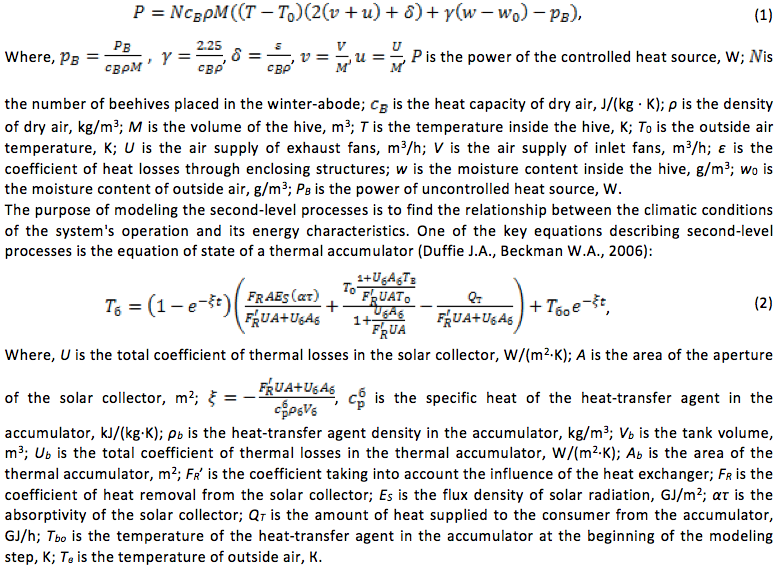
The simulation of the operation of the system based on a hybrid solar power plant was carried out as follows. At the first stage, the values of input factors of the model were set and remained constant taking into account accepted assumptions. The factors of this group included the number of hives placed in the winter-abode, the design parameters of hives, winter-abode and individual units of the system (photoelectric modules, solar collector), as well as other parameters. At the next stage input parameters, the values of which varied for each step of the simulation, were set. Factors of this group included temperature, wind speed, absolute air humidity, air density and the amount of diffuse (scattered) solar energy entering the horizontal surface. Then the substitution of the values of the input factors into the calculations followed, and the pattern of the influence (functional, random) and the conditions for changing the parameters over time were determined. In the calculations within the modeling step, an assumption that implied a constant condition during it was made. The modeling step was chosen taking into account the consistency of the conditions during it. Then, the values for the simulation step were written to the result table. Changes in external conditions were made depending on their fluctuations over time. The input parameters modified during the step were substituted into the calculation part in the next step of the simulation. Then the process was repeated until the last step of the simulation. As a result of calculating the mathematical model, a table of output data consisting of the values of the calculated parameters at each step of the simulation was obtained.
To find the optimal parameters of a hybrid system, an optimization technique has been developed. The evaluation of the effectiveness of the system was considered in two aspects: with respect to the transformation and transmission of energy and with respect to the specific consumption of material resources. In this regard, we chose two criteria that characterized the efficiency for each aspect of the operation of the system, which were the efficiency and the material consumption.
The list of optimized parameters of the autonomous system for ensuring the optimal microclimate of bee hives included the total area of the aperture of the photovoltaic modules, the area of the aperture of the solar collector, the capacity of the electric and thermal accumulators. Dependences between the optimality criteria and the optimized parameters are given in Eq. 3 and Eq. 4:
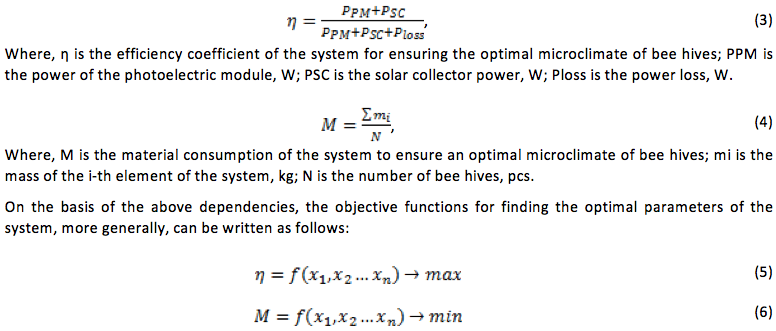
To find the dependencies between the values of the optimized parameters and the masses of the individual structural units of the system, an analysis in the field of nominal series of commercially available photoelectric modules, solar collectors, and energy accumulators was carried out.
The analysis technique in the field of nominal series of individual technical products for the system included the following stages:
The obtained dependencies are shown in Figure 2.
Fig. 2
Dependences between the masses of individual units and the values of optimized
parameters (Figures a-d are the dependencies between the masses of individual units
of the system (including auxiliary equipment) and the values of the optimized
parameters within the nominal series of serially produced units)
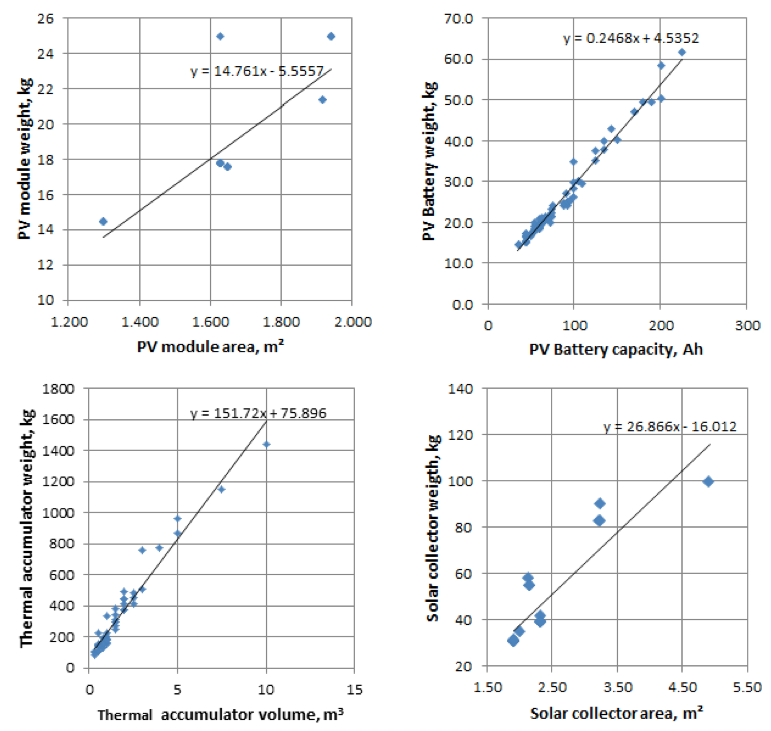
Optimization was carried out by the method of an exhaustive search of possible combinations of values of optimized parameters and their substitution into the mathematical model of operation of a hybrid system. At the end of the optimization process, a set of values of efficiency criteria was determined for the chosen range of variation of the optimized parameters. Then, a set of Pareto optimal values of objective functions was determined, each of which corresponded to a certain combination of values of optimized parameters. The latter implied finding a set of solutions, in which each state of the system characterized by the corresponding values of the objective functions, could not be improved without degradation of the values of any performance indicator.
Figure 3 shows the results of modeling the operation of the system based on a hybrid solar power plant for the following conditions:
• Location of the apiary is the Republic of Mari El;
• A winter-abode is for 250-bee colonies (model project No. 808-5-4);
• The area of the photoelectric module (PM) is 1.3 m2; the number of modules is 10;
• Swept area of wind power installation (WPI) is 18 m2;
• Battery capacity is 50 A*h;
• The volume of the tank of the thermal accumulator (TA) is 3 m3;
• Time interval of modeling is from Oct, 14 to Apr, 14.
Fig. 3 - Results of modeling the operation of the hybrid system
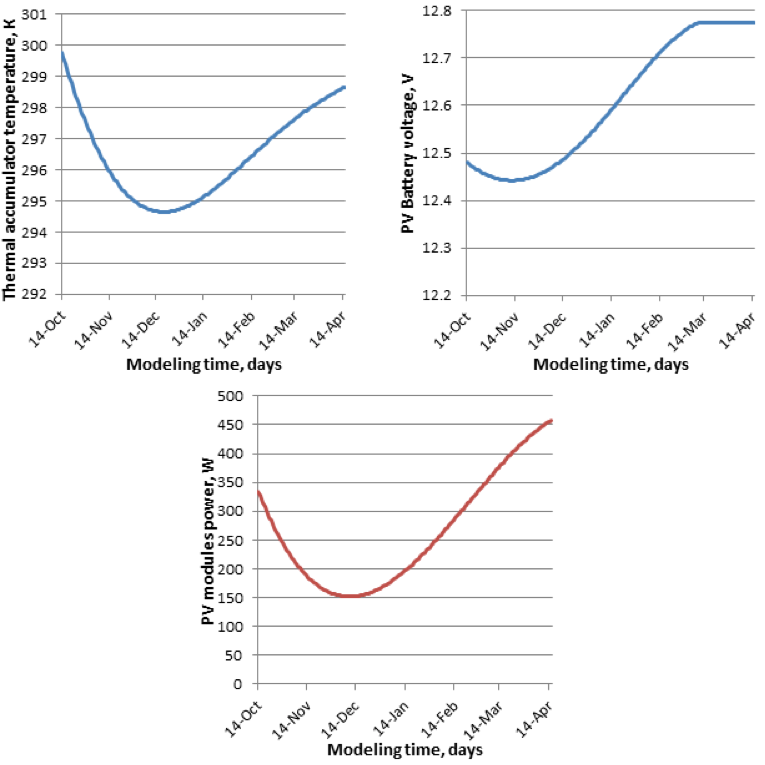
Graphic representation of the results of the technical parameters optimization of the system based on a hybrid solar-wind installation is shown in Fig. 4.
Fig.4
Set of Pareto optimal values of objective functions
a) The results of an exhaustive search;
b) The set of Pareto optimal values of objective functions
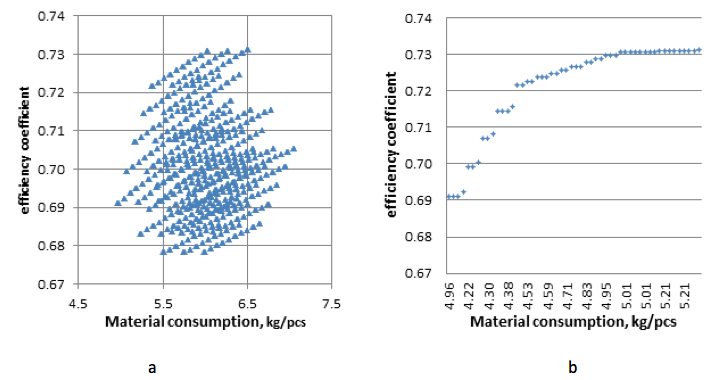
a) The results of an exhaustive search; b) The set of Pareto optimal values of objective functions
Analyzing the data obtained during optimization, it can be concluded that the optimal ratio from the viewpoint of the minimum of material consumption is the ratio of the technical parameter values given in Table 1.
Table 1
Optimal Parameter Values (Republic of Mari El)
Coefficient of Efficiency |
Material Consumption, kg/hive |
Area of the Aperture of PM, m2 |
Capacity of the Battery, A*h |
Area of the Aperture of SC, m2 |
Volume of TA, m3 |
0,691 |
4,96 |
3,891 |
35 |
5,73 |
0,9 |
1) The developed mathematical model makes it possible to determine the pattern of the qualitative and quantitative dependencies between the technical parameters of the system and the indices of its effectiveness provided that the optimal microclimate of beehives is maintained.
2) Optimization of the technical parameters of the system allows you to select the optimal ratio of the values of the equipment parameters in accordance with the objective optimization functions. Based on 18 hives for the climatic conditions of the Republic of Mari El, the optimal parameters of the system are the following:
• The aperture area of the photovoltaic modules is 3,891 m2;
• The solar collector aperture area is 5,73 m2;
• The storage battery capacity is 35 A*h;
• The volume of the thermal accumulator tank is 0,9 m3.
3) On the basis of the proposed ratios of the technical parameters, we obtained the ratio of efficiency and material consumption (Efficiency/MC) for the Republic of Mari El: 0,691/4,96.
1. Van Muyden, Willem George Frederik. (1985). Bee hive assembly. EP19820200428.
2. Kretschmann Theodore R. (1991). Cover for beehives. US 4983139.
3. Soronin, S.M. (2012). The formation of autonomous power supply systems of agricultural facilities based on renewable energy sources, M. S. thesis, Zernograd, 13-15.
4. Horton, David J. (1985). Solar heating system for beehives and other enclosures. US4494528
5. Merrit I. Taylor. (1981). Beehives. US4300250.
6. Junqueira de Souza, Regattieri Sampaio, Golin Buzzatti. (2010). Device for hygienizing, warming, and dehumidifying a beehive. US7666057.
7. Duffie J.A., Beckman W.A. (2006). Solar Engineering of Thermal Processes, Third Edition, John Wiley & Sons, 375-379.
1. Mari State University, Yoshkar-Ola, Russian Federation; Contact E-mail: eef@marsu.ru
2. Mari State University, Yoshkar-Ola, Russian Federation
3. Volga State University of Technology, Yoshkar-Ola, Russian Federation
4. Volga State University of Technology, Yoshkar-Ola, Russian Federation
5. Volga State University of Technology, Yoshkar-Ola, Russian Federation